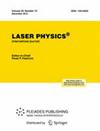PCD 刀具的激光加工特性及建模分析
IF 1.1
4区 物理与天体物理
Q4 OPTICS
引用次数: 0
摘要
本研究通过深入分析纳秒激光烧蚀聚晶金刚石(PCD)纹理刀具加工系统的实验细节和成形模式,探讨了散焦量、激光功率和脉冲频率对 PCD 刀具表面微坑纹理的微观形态和尺寸的影响。实验结果表明,不同参数下产生的微坑纹理具有多样性,包括圆形结构、碎片、重铸层和热影响区。微坑的直径和深度受到散焦量、激光功率和脉冲频率的综合影响,呈现出复杂的形态。在全面分析了各参数对纹理形态的影响后,引入了人工神经网络(ANN)模型来预测微坑尺寸。通过对模型的训练和优化,获得了对微坑直径和深度的精确预测。与传统的回归模型相比,人工神经网络模型表现出卓越的预测性能,验证了其在复杂加工过程中的适用性。这项研究不仅让我们对 PCD 纹理刀具的加工模式有了深刻的了解,还为今后类似加工过程的优化和控制提供了有效的预测模型。本文章由计算机程序翻译,如有差异,请以英文原文为准。
Laser processing characteristics of PCD tool and modeling analysis
Through in-depth analysis of the experimental details and forming patterns of the nanosecond laser ablation polycrystalline diamond (PCD) textured tool processing system, this study explores the microscopic morphology and dimensions of micro-pits texture on the surface of PCD tools influenced by defocus amount, laser power, and pulse frequency. Experimental results indicate that the micro-pit textures generated under different parameters exhibit diversity, including rounded structure, fragments, recast layers, and heat-affected zones. The diameter and depth of micro-pits are comprehensively affected by defocus amount, laser power, and pulse frequency, showing complex patterns. After a thorough analysis of the effects of each parameter on the texture morphology, an artificial neural network (ANN) model is introduced for the prediction of micro-pit dimensions. Through model training and optimization, accurate predictions of micro-pit diameter and depth are obtained. In comparison to traditional regression models, the ANN model demonstrates outstanding predictive performance, validating its applicability in complex machining processes. This study not only provides a profound understanding of the processing patterns of PCD textured tools but also offers an effective predictive model for the optimization and control of similar future machining processes.
求助全文
通过发布文献求助,成功后即可免费获取论文全文。
去求助
来源期刊

Laser Physics
物理-光学
CiteScore
2.60
自引率
8.30%
发文量
127
审稿时长
2.2 months
期刊介绍:
Laser Physics offers a comprehensive view of theoretical and experimental laser research and applications. Articles cover every aspect of modern laser physics and quantum electronics, emphasizing physical effects in various media (solid, gaseous, liquid) leading to the generation of laser radiation; peculiarities of propagation of laser radiation; problems involving impact of laser radiation on various substances and the emerging physical effects, including coherent ones; the applied use of lasers and laser spectroscopy; the processing and storage of information; and more.
The full list of subject areas covered is as follows:
-physics of lasers-
fibre optics and fibre lasers-
quantum optics and quantum information science-
ultrafast optics and strong-field physics-
nonlinear optics-
physics of cold trapped atoms-
laser methods in chemistry, biology, medicine and ecology-
laser spectroscopy-
novel laser materials and lasers-
optics of nanomaterials-
interaction of laser radiation with matter-
laser interaction with solids-
photonics
 求助内容:
求助内容: 应助结果提醒方式:
应助结果提醒方式:


